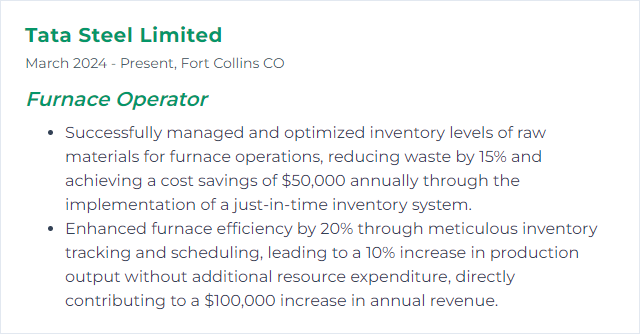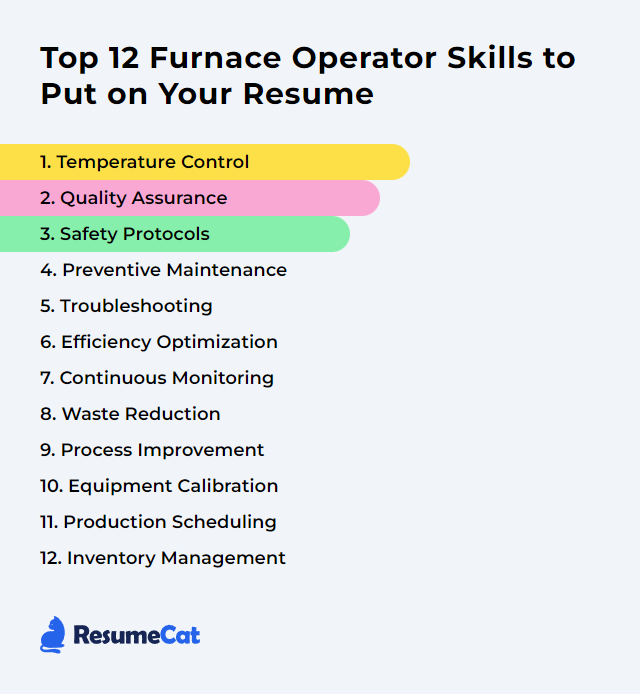Top 12 Furnace Operator Skills to Put on Your Resume
Hiring teams skim fast. A resume that surfaces the right furnace-operator skills gets noticed, gets interviews, and quietly says “I can run this line safely and efficiently.” Below, the 12 essentials—clear, practical, and geared to today’s shop floors.
Furnace Operator Skills
- Temperature Control
- Quality Assurance
- Safety Protocols
- Preventive Maintenance
- Troubleshooting
- Efficiency Optimization
- Continuous Monitoring
- Waste Reduction
- Process Improvement
- Equipment Calibration
- Production Scheduling
- Inventory Management
1. Temperature Control
Temperature control means watching, adjusting, and verifying furnace heat so materials see the right temperature at the right time—no more, no less.
Why It's Important
It protects product quality, prevents damage, cuts energy waste, and keeps operations safe and consistent.
How to Improve Temperature Control Skills
Make accuracy routine and drift rare:
Calibration: Calibrate sensors, thermocouples, and controllers on a set cadence; document results and correct for drift.
Upgrade Controls: Use modern PID or model-based controls with proper tuning to tighten stability and response.
Insulation & Seals: Inspect refractory, doors, and joints; repair hot spots and air leaks to curb heat loss.
Preventive Checks: Find bad probes, wiring faults, and leaking fuel/air lines before they skew readings.
Data Logging: Record profiles, ramps, and soaks; analyze trends, adjust setpoints, and refine recipes.
Operator Training: Cross-train on equipment specifics, alarm logic, and control philosophy.
Do this well and parts come out on spec, cycles tighten, and energy bills ease up.
How to Display Temperature Control Skills on Your Resume
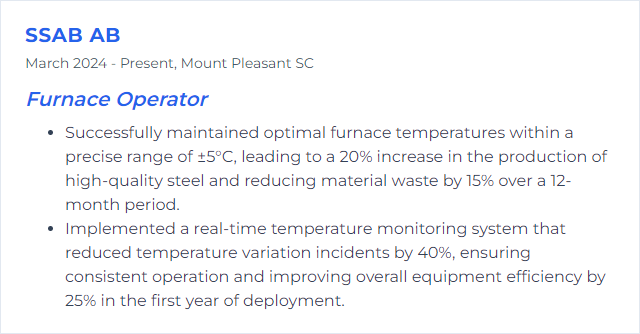
2. Quality Assurance
Quality Assurance for furnace work means processes and outputs match spec—temperatures, atmospheres, handling, and final results—consistently.
Why It's Important
It reduces scrap and rework, protects customers, and keeps audits painless. Reliability builds trust.
How to Improve Quality Assurance Skills
- Training: Keep operators current on procedures, critical-to-quality parameters, and acceptance criteria.
- Standardization: Use clear work instructions and documented standards so every shift runs the same playbook.
- Maintenance: Maintain the furnace and instruments on schedule to avoid quality drift.
- Monitoring: Track process data in real time; act quickly on deviations.
- Feedback Loop: Capture defects, root causes, and fixes; feed lessons back into procedures.
How to Display Quality Assurance Skills on Your Resume

3. Safety Protocols
Safety protocols are the non-negotiables: PPE, correct startup/shutdown, hazard controls, lockout/tagout, and emergency actions—drilled until automatic.
Why It's Important
High heat, fuel, moving parts, and gases demand discipline. Protocols prevent burns, fires, explosions, and exposures.
How to Improve Safety Protocols Skills
Regular Training: Refresh on furnace hazards, emergency response, and PPE. Practice matters.
Inspections & Maintenance: Find issues early—gas leaks, refractory failures, fan faults—and fix them fast.
PPE Compliance: Heat-resistant gloves, face shields, eye protection, hearing protection—always.
Emergency Readiness: Keep action plans current; run drills for fire, power loss, and gas alarms.
Clear Signage: Hot surfaces, pinch points, trip and burn hazards marked and visible.
Risk Assessment: Reassess hazards periodically and after process changes; close gaps.
How to Display Safety Protocols Skills on Your Resume
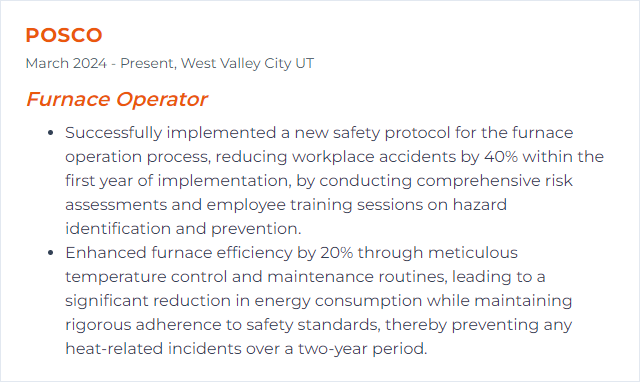
4. Preventive Maintenance
Preventive maintenance is planned inspection, cleaning, adjustment, and parts replacement that keeps furnaces healthy and productive.
Why It's Important
Fewer breakdowns, safer operation, longer equipment life, better efficiency—downtime shrinks and schedules hold.
How to Improve Preventive Maintenance Skills
Structured Inspections: Use checklists for burners, blowers, valves, sensors, refractory, and controls.
Predictive Tools: Apply thermal imaging, vibration checks, and gas analysis to spot early failures.
Skills Development: Train techs and operators on diagnostics and OEM procedures.
Cleaning Discipline: Remove scale, soot, and debris; keep air and fuel paths clear.
Spare Parts Readiness: Stock critical spares and label locations to slash MTTR.
Maintenance Software: Use a CMMS to schedule, track, and analyze work and parts usage.
How to Display Preventive Maintenance Skills on Your Resume
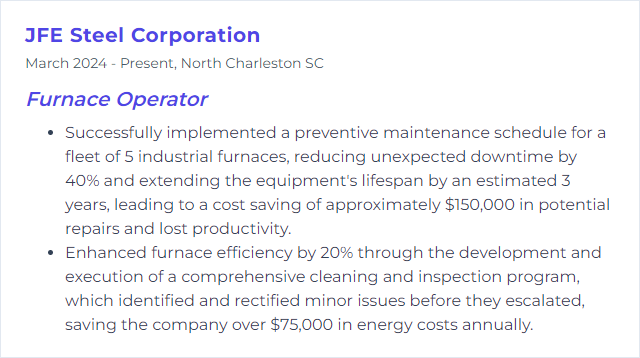
5. Troubleshooting
Troubleshooting is the hunt: diagnose symptoms, confirm causes, and fix furnace issues quickly and safely.
Why It's Important
Fast, correct fixes protect throughput, quality, and equipment. Downtime costs—good troubleshooting cuts it.
How to Improve Troubleshooting Skills
Know the System: Study P&IDs, wiring diagrams, and operating limits; understand normal behavior.
Catalog Common Faults: Ignition failures, flame instability, sensor drift, fan issues—build playbooks.
Use the Right Tools: Thermocouples, multimeters, manometers, analyzers, cameras—measure, don’t guess.
Logical Flow: Start simple, verify power/air/fuel, then step deeper; change one variable at a time.
Leverage Resources: OEM manuals, internal knowledge bases, and peer forums help validate hypotheses.
Keep Learning: New controls and sensors arrive often; stay current with courses and workshops.
How to Display Troubleshooting Skills on Your Resume
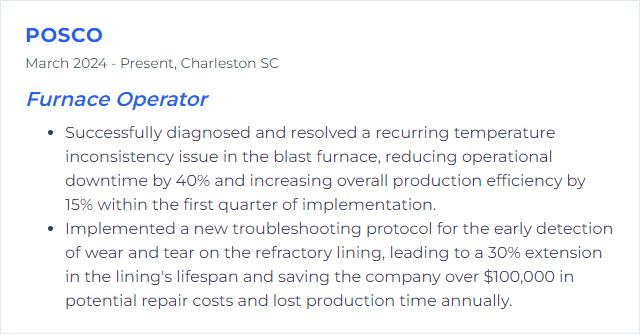
6. Efficiency Optimization
Efficiency optimization tunes conditions and practices to yield more good product per unit of energy and time—less waste, more output.
Why It's Important
Lower operating costs, higher throughput, and a smaller environmental footprint. Everyone wins.
How to Improve Efficiency Optimization Skills
Cut Heat Loss: Maintain insulation and seals; find hot spots and air leaks; fix them.
Right-Size Loads: Plan uniform, optimal loading; avoid partial or uneven charges that burn extra fuel.
Maintain Relentlessly: Clean heat exchangers, tune burners, and check combustion regularly.
Targeted Upgrades: Retrofit efficient burners, VFDs, and modern controls where ROI is clear.
Train for Efficiency: Operators who understand energy drivers make smarter adjustments in the moment.
How to Display Efficiency Optimization Skills on Your Resume

7. Continuous Monitoring
Continuous monitoring means real-time eyes on temperatures, pressures, atmospheres, emissions, power draw—then acting before small hiccups become downtime.
Why It's Important
It keeps the process in the safe, optimal window. Faster detection, fewer surprises, steadier quality.
How to Improve Continuous Monitoring Skills
Use Quality Sensors: Install reliable, well-placed sensors and replace them before they drift.
Connect the Data: Tie instruments into SCADA/MES dashboards with alerts that matter.
Predict, Don’t React: Apply analytics to spot patterns that precede failures; schedule fixes proactively.
Train Operators: Teach what “normal” looks like and how to respond to abnormal trends.
Improve Continuously: Review events monthly; tune alarms, add sensors, refine limits.
How to Display Continuous Monitoring Skills on Your Resume
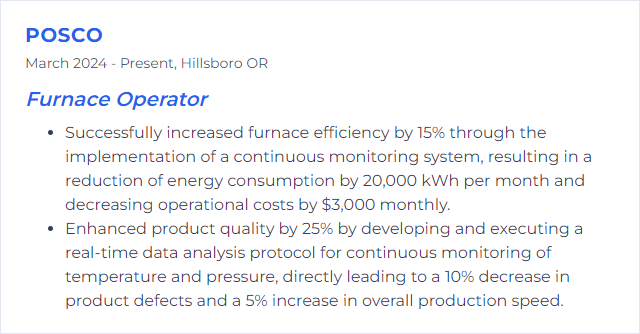
8. Waste Reduction
Waste reduction trims scrap, rework, excess energy, and leftover materials. Smarter inputs, tighter processes, cleaner outputs.
Why It's Important
Lower costs, greener operations, and leaner flow. Less waste means more value.
How to Improve Waste Reduction Skills
Run Efficiently: Maintain setpoints, minimize overshoot, and hold soak times to spec.
Recycle Where Possible: Reclaim metals and packaging; segregate streams to keep recyclables clean.
Optimize Processes: Apply lean tools to remove bottlenecks and overprocessing.
Train the Team: Teach handling and measurement techniques that prevent spills and mishaps.
Sort at the Source: Clear bins and labels prevent contamination and simplify disposal.
How to Display Waste Reduction Skills on Your Resume
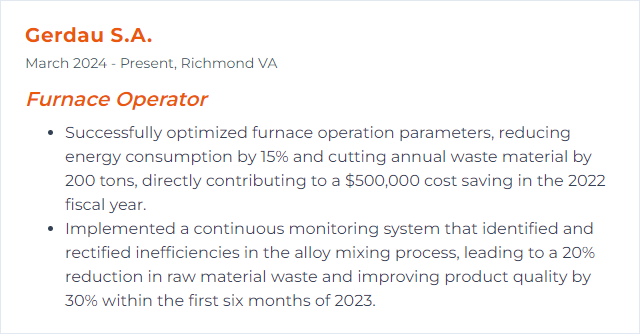
9. Process Improvement
Process improvement sharpens how work flows—less waiting, fewer defects, simpler steps, safer tasks.
Why It's Important
Better throughput, steadier quality, safer shifts, lower costs. Margins come from method.
How to Improve Process Improvement Skills
Measure First: Capture cycle times, temperatures, yields, and downtime; apply SPC to watch stability.
Grow Skills: Train operators to spot waste and suggest fixes; empower them to try small trials.
Predictive Maintenance: Prevent surprises by addressing wear before it breaks schedules.
Lean Thinking: Remove overproduction, waiting, transport, overprocessing, inventory, motion, defects.
Smart Tech: Add IoT-enabled sensing and control where visibility is poor and variation is high.
How to Display Process Improvement Skills on Your Resume
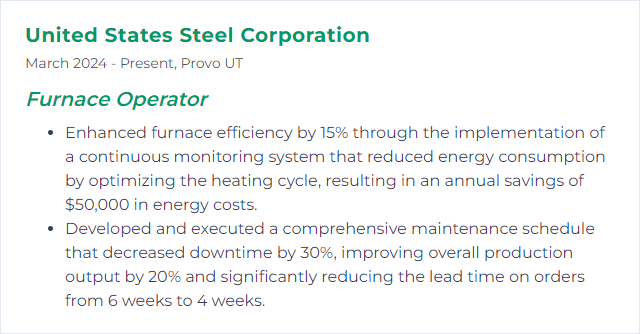
10. Equipment Calibration
Equipment calibration aligns instruments and controls to known standards so readings are accurate and repeatable.
Why It's Important
Precise temperature and uniform heat drive consistent quality, safety compliance, and energy efficiency.
How to Improve Equipment Calibration Skills
Set a Schedule: Calibrate on defined intervals and after repairs or drifts; track due dates.
Use Known Standards: Verify against certified references and keep certificates on file.
Call in Specialists: For complex instruments, use accredited calibration services.
Train Thoroughly: Teach proper setup, offsets, and documentation practices.
Document Everything: Log results, adjustments, and as-found/as-left readings; review trends.
Control the Environment: Stabilize ambient temperature and humidity during calibration.
Use Software: A calibration management tool prevents misses and organizes records.
How to Display Equipment Calibration Skills on Your Resume
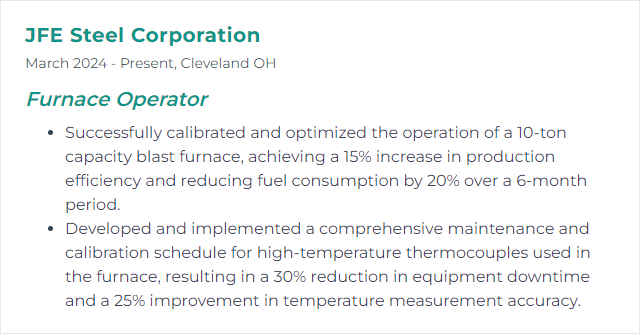
11. Production Scheduling
Production scheduling sets the order, start times, and duration of furnace runs so deadlines hold and machines stay busy, not jammed.
Why It's Important
Good schedules raise utilization, reduce changeovers, and meet delivery promises while leaving room for maintenance.
How to Improve Production Scheduling Skills
Think Lean: Shorten changeovers and cut WIP so schedules can flex without chaos.
Use Scheduling Tools: Deploy software that handles constraints like soak times, batch sizes, and maintenance windows.
Plan Loads Smartly: Balance charge size and mix to minimize idle time and bottlenecks.
Tight Communication: Keep production, maintenance, and quality synced with real-time updates.
Iterate: Review adherence, find misses, and refine rules based on actual performance.
Train the Team: Make sure planners and operators understand the logic behind the schedule.
How to Display Production Scheduling Skills on Your Resume
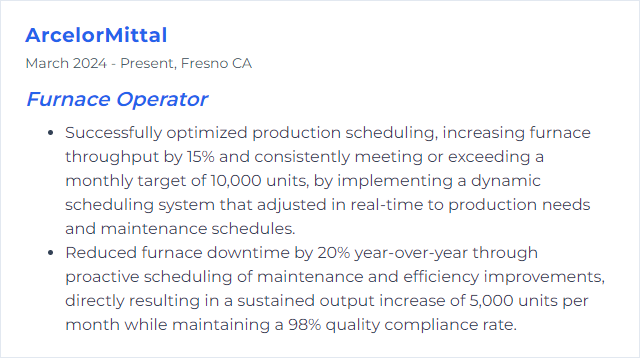
12. Inventory Management
Inventory management tracks raw materials, fuel, consumables, and spares so production runs smoothly without tying up cash in excess stock.
Why It's Important
Right materials at the right time, fewer stockouts, controlled costs, and reliable lead times.
How to Improve Inventory Management Skills
Adopt Inventory Software: Track receipts, usage, and reorders in real time.
Audit Regularly: Cycle counts and periodic audits keep records honest.
Strengthen Suppliers: Monitor on-time delivery, quality, and responsiveness; keep backups.
Forecast Demand: Use history and schedules to set min/max levels and reorder points.
Lean Stock: Strip excess, standardize parts, and shorten replenishment loops.
Continuous Improvement: Review KPIs—turns, accuracy, stockouts—and adjust parameters.
How to Display Inventory Management Skills on Your Resume
